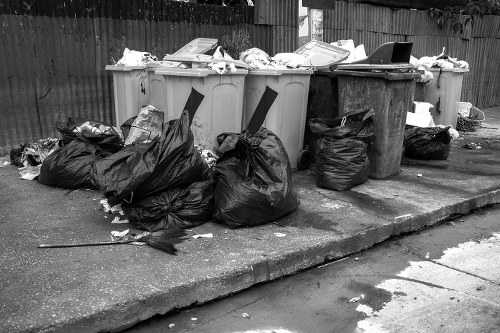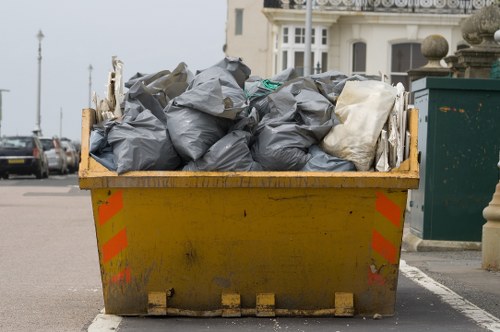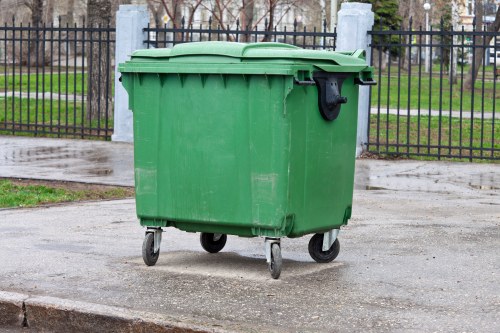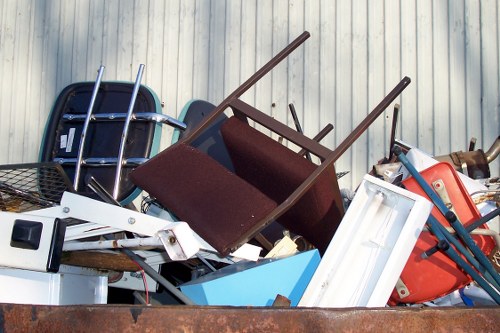Construction Waste Clearance in Southfields

Understanding Construction Waste Clearance
Construction projects in Southfields generate a significant amount of waste, ranging from concrete debris to packaging materials. Effective construction waste clearance is essential not only for maintaining a clean and safe construction site but also for ensuring environmental sustainability. Proper waste management minimizes the impact on the surrounding community and complies with local regulations.
In Southfields, the demand for reliable waste clearance services has grown alongside the construction boom. Whether it's a small renovation or a large-scale development, having a dependable service provider can make a substantial difference in project efficiency and cost-effectiveness.
Construction waste clearance involves the systematic removal, sorting, and disposal of waste materials generated during construction activities. This process ensures that valuable resources are recycled or reused, reducing the overall environmental footprint of the project.

Types of Construction Waste
Construction waste encompasses a variety of materials, each requiring specific handling and disposal methods. Understanding the different types of waste is crucial for effective clearance and recycling.
- Concrete and Masonry: These are some of the most common construction wastes, often resulting from demolition or over-excavation.
- Wood and Timber: Includes off-cuts, pallets, and other wooden materials used in construction.
- Metal: Steel, aluminum, and other metals used in construction can be recycled efficiently.
- Bricks and Tiles: Often reused in new construction projects, minimizing the need for new materials.
- Packaging Materials: Includes cardboard, plastic, and other packaging waste generated from construction supplies.
Proper identification and categorization of construction waste enable effective recycling and disposal, reducing landfill usage and promoting sustainability.
Efficient waste management not only helps in maintaining a clean work environment but also contributes to the overall success of construction projects by minimizing delays and additional costs.

Benefits of Professional Waste Clearance Services
Engaging professional construction waste clearance services in Southfields offers numerous advantages for construction projects of all sizes. These benefits extend beyond mere waste removal, enhancing overall project efficiency and sustainability.
Cost-Effective Solutions
Professional waste clearance services provide cost-effective solutions by managing the entire waste disposal process. This eliminates the need for construction companies to invest in their own waste management infrastructure, reducing overall project costs.
Time Savings
Outsourcing waste clearance allows construction teams to focus on their core tasks, leading to improved productivity and faster project completion times. Professionals handle the logistics, ensuring timely removal and disposal of waste materials.
Compliance with Regulations
Construction waste disposal is subject to strict local regulations and environmental standards. Professional services ensure compliance, avoiding potential fines and legal issues associated with improper waste management.

Steps Involved in Construction Waste Clearance
The waste clearance process involves several key steps to ensure efficient and environmentally responsible disposal of construction debris. Understanding these steps can help construction managers and contractors plan their waste management strategies effectively.
- Assessment: Evaluating the type and volume of waste generated during the construction project.
- Sorting and Segregation: Separating recyclable materials from non-recyclable ones to maximize recycling rates.
- Collection: Gathering the sorted waste using appropriate containers and transportation methods.
- Transportation: Moving the collected waste to designated recycling centers or disposal facilities.
- Recycling and Disposal: Processing recyclable materials and disposing of non-recyclable waste in an environmentally friendly manner.
Each step requires careful planning and execution to ensure that waste clearance is efficient and adheres to environmental guidelines.
Effective waste clearance not only improves site safety but also contributes to the overall sustainability of construction projects.

Choosing the Right Waste Clearance Service in Southfields
Selecting the appropriate waste clearance service is critical for the success of any construction project in Southfields. Several factors should be considered to ensure that the service provider meets the specific needs and standards of the project.
Experience and Expertise
Opt for companies with a proven track record in construction waste management. Experienced providers are better equipped to handle various types of waste and can offer valuable insights into efficient disposal practices.
Comprehensive Services
Choose a service that offers a wide range of waste management solutions, including recycling, disposal, and on-site sorting. Comprehensive services minimize the need to engage multiple providers, streamlining the waste clearance process.
Environmental Commitment
Ensure that the waste clearance service prioritizes environmental sustainability. Providers should adhere to recycling protocols and strive to minimize landfill waste, aligning with green building practices.
Competitive Pricing
Cost is a significant factor in selecting a waste clearance service. Obtain detailed quotes and compare pricing structures to find a provider that offers quality services within your budget constraints.
By carefully evaluating these factors, construction managers can select a waste clearance service that enhances project efficiency and sustainability.
Environmental Impact of Construction Waste
Construction waste has a substantial impact on the environment, contributing to landfill overflow, resource depletion, and pollution. Effective waste clearance practices are essential in mitigating these negative effects and promoting sustainable construction.
Recycling construction materials reduces the need for new raw materials, conserving natural resources and lowering the environmental footprint of construction projects. Additionally, proper waste management minimizes greenhouse gas emissions by decreasing landfill methane production.
Implementing sustainable waste clearance strategies aligns with global efforts to combat climate change and promotes responsible construction practices. It also enhances the reputation of construction companies as environmentally conscious entities.
Innovations in Waste Clearance Technology
The waste management industry continually evolves with advancements in technology, leading to more efficient and sustainable construction waste clearance methods. Embracing these innovations can significantly enhance waste management practices in Southfields.
Automated Sorting Systems
Modern sorting systems use automation and artificial intelligence to accurately segregate different types of waste, increasing recycling rates and reducing manual labor requirements.
Mobile Waste Processing Units
Mobile units enable on-site processing of waste, reducing transportation needs and allowing for immediate recycling of materials, which enhances efficiency.
Sustainable Transportation Solutions
Electric and hybrid waste collection vehicles are being adopted to minimize carbon emissions associated with waste transportation, contributing to greener construction practices.
Integrating these technologies into waste clearance operations leads to more sustainable and cost-effective construction projects.
Regulatory Framework for Waste Clearance in Southfields
Navigating the regulatory landscape is a crucial aspect of construction waste clearance. Southfields has specific regulations and guidelines that construction projects must adhere to for proper waste management.
- Waste Management Plans: Larger construction projects may be required to develop comprehensive waste management plans outlining how waste will be handled and disposed of.
- Permits and Licenses: Obtaining necessary permits for waste transportation and disposal is mandatory to ensure compliance with local laws.
- Recycling Targets: Some regulations set specific recycling targets that construction projects must meet, encouraging higher recycling rates.
- Reporting and Documentation: Maintaining accurate records of waste generation, sorting, and disposal is often required for regulatory compliance and auditing purposes.
Adhering to these regulations ensures that construction projects operate within legal frameworks, avoiding penalties and fostering responsible waste management practices.
Staying informed about regulatory changes and updates is essential for construction managers to maintain compliance and implement best practices in waste clearance.
Best Practices for Effective Waste Clearance
Implementing best practices in waste clearance can significantly improve the efficiency and sustainability of construction projects in Southfields. These practices ensure that waste is managed responsibly and resources are utilized optimally.
Early Planning and Coordination
Integrate waste management strategies into the project planning phase. Coordinating with waste clearance services early ensures that waste removal aligns with project timelines and milestones.
On-Site Sorting and Segregation
Establish designated areas for sorting different types of waste on-site. This facilitates easier recycling and disposal, reducing contamination and increasing recycling rates.
Employee Training and Awareness
Educate construction workers about proper waste handling procedures. Training ensures that all team members understand the importance of waste segregation and follow established protocols.
By adopting these best practices, construction projects can achieve more efficient waste management, reduce environmental impact, and lower overall costs.
Recycling and Reuse Opportunities
Recycling and reusing construction waste is a key component of sustainable waste management. Southfields offers numerous opportunities to repurpose materials, reducing the demand for new resources and minimizing landfill usage.
- Concrete Recycling: Crushed concrete can be reused as aggregate for new construction projects, reducing the need for virgin materials.
- Wood Repurposing: Salvaged wood can be used in new structures, furniture, or other applications, extending its lifecycle.
- Metal Recovery: Metals such as steel and aluminum are highly recyclable and can be melted down and reused in various industries.
- Brick and Tile Reuse: Intact bricks and tiles can be cleaned and reused in new construction, preserving their integrity and aesthetic value.
Maximizing recycling and reuse not only benefits the environment but also offers cost savings for construction projects by reducing material procurement expenses.
Embracing recycling initiatives contributes to a circular economy, where materials are continuously reused and kept out of landfills.
Challenges in Construction Waste Clearance
Despite the benefits, several challenges can impede effective construction waste clearance in Southfields. Recognizing and addressing these obstacles is essential for improving waste management practices.
Lack of Awareness
Many construction professionals may not be fully aware of the latest waste management techniques and recycling opportunities, leading to inefficient waste handling.
Limited Recycling Facilities
The availability of local recycling centers and facilities can limit the ability to recycle certain types of construction waste, necessitating transportation to more distant locations.
Cost Constraints
Budget limitations can prevent construction projects from investing in comprehensive waste management solutions, leading to improper disposal practices.
Overcoming these challenges requires collaboration between construction companies, waste clearance services, and regulatory bodies to promote awareness, enhance infrastructure, and provide financial incentives for sustainable waste management.
Future Trends in Construction Waste Management
The future of construction waste clearance in Southfields is poised for significant advancements driven by technology, policy changes, and increasing environmental consciousness.
Smart Waste Management Systems
Integration of IoT and data analytics into waste management can provide real-time tracking of waste generation and disposal, optimizing clearance operations and enhancing transparency.
Enhanced Recycling Technologies
Innovations in recycling technologies will enable more efficient processing of complex construction materials, increasing recycling rates and reducing waste.
Green Building Certifications
Obtaining certifications such as LEED or BREEAM will become increasingly important, driving the adoption of superior waste management practices in construction projects.
These trends will contribute to more sustainable construction practices, aligning with global efforts to reduce environmental impact and promote responsible resource use.
Staying ahead of these trends ensures that construction projects in Southfields remain competitive and environmentally compliant.
Conclusion
Effective construction waste clearance is a critical component of successful and sustainable construction projects in Southfields. By understanding the types of waste, leveraging professional services, adhering to regulations, and adopting best practices, construction teams can significantly reduce their environmental footprint and enhance project efficiency.
Embracing recycling and reuse opportunities, overcoming challenges, and staying informed about future trends will further solidify the role of responsible waste management in the construction industry. Investing in proper waste clearance not only benefits the environment but also contributes to the overall success and reputation of construction projects.
Contact us today to learn more about our comprehensive construction waste clearance services in Southfields and take the first step towards a cleaner, greener construction site.